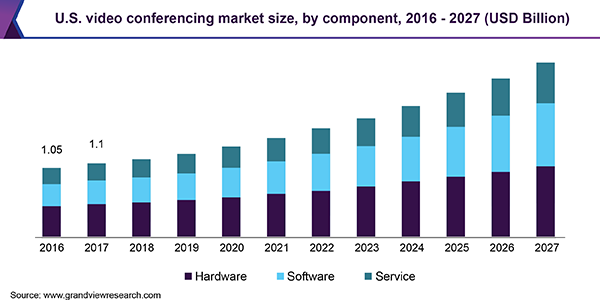The global video conferencing market size is expected to reach USD 8.56 billion by 2027, expanding at a CAGR of 9.9% from 2020 to 2027, according to a new study conducted by Grand View Research, Inc. Growing usage of these solutions in startups, educational institutes,and organizations, especially in the emerging countries of Asia Pacific, are expected to drive the market. Moreover, proliferation of 4G-enabled mobile devices and rise in the number of Video Conferencing-as-a-Service (VCaaS) providers are expected to contribute to market growth.
Recently, majority of the countries in Asia Pacific witnessed the development of robust digital communication infrastructure that created the need for deployment of these systems. Various telecom companies are providing funding to the manufactures for the development of these systems, which is expected to positively impact the market growth. For instance, in February 2018, NTT Limited provided funding worth USD 32 million to Highfive for the development of integrated hardware and software video conferencing solutions.
Growth of the telemedicine industry and increased penetration of online education in developed as well as emerging economies, such as U.K., U.S., Japan, India, and China, are anticipated to play a pivotal role in driving the demand for these systems over the forecast period. Additionally, it is anticipated that growing focus of electronic companies, such as Koninklijke Philips N.V. and Siemens, on establishing partnerships with market players will drive the video conferencing market. For instance, in March 2017, Koninklijke Philips N.V. and Vidyo Inc. collaborated to launch Philips IntelliSpace eCareManager telehealth platform, which allowed doctors to remotely monitor patients in the Intensive Care Unit (ICU).
In response to the outbreak of the COVID-19 pandemic, governments are providing funding to the law enforcement agencies to adopt these solutions for carrying out their operations remotely. For instance, in April 2020, the Ohio Supreme Court announced a funding of USD 4 million to high courts for purchasing video conferencing systems. Demand for remote workforce management using these systems has increased owing to the rapid globalization. Deployment of video conferencing solutions has enabled businesses to communicate with multiple teams or clients in different locations more effectively.

Further key findings from the study suggest:
- In September 2017, AVer Information Inc. and TrueConf LLC entered into a partnership, which enabled AVer’s video conferencing systems to operate with TrueConf‘s TrueConf video conferencing software. Such partnerships are projected to enhance the growth of the software component segment
- Based on deployment, cloud-based solutions are anticipated to witness increased demand due to growing trend of Bring Your Own Device (BYOD). These solutions enable users to join a meeting using any device through a web-based browser
- On the basis of enterprise size, the small and medium enterprises segment is expected to witness significant growth in coming years owing to increasing adoption of video conferencing solutions by SMEs for interviewing new candidates
- By end use, the healthcare sector is expected to witness considerable growth in future owing to increasing focus of the mental health practitioners in the healthcare organizations, such as the National eTherapy Centre and Commonwealth Department of Health, on the usage of video conferencing to provide remote consultations to their patients
- Asia Pacific is anticipated to witness the fastest growth in coming years owing to strong presence of Business Process Outsourcing (BPO) and Knowledge Process Outsourcing (KPO) companies. In addition, major global manufacturing and IT companies have established their R&D and production centers in the region
- Key industry players operating in the video conferencing market include Array Telepresence Inc.; Adobe Inc.; Avaya Inc.; Huawei Technologies Co., Ltd.; Logitech International S.A.; West Corporation, Plantronics, Inc.; Vidyo Inc.; Microsoft Corporation; and Cisco Systems, Inc.